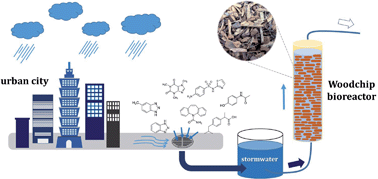Pharmaceutical and anticorrosive substance removal by woodchip column reactor: removal process and effects of operational parameters†
Abstract
Urban stormwater has recently been considered a potential water resource to augment urban water supplies; however, the existence of emerging contaminants limits urban stormwater utilization. This study aims to use woodchip bioreactors, which are natural and inexpensive, to remove emerging contaminants from artificial stormwater, with a focus on the contaminant removal processes in the woodchip bioreactor and on the effects of operational parameters on the system performance. Seven commonly detected emerging contaminants – acetaminophen (ACE), caffeine (CAFF), carbamazepine (CBZ), ibuprofen (IBU), sulfathiazole (SFZ), benzotriazole (BT) and 5-methyl-1H-benzotriazole (5-MeBT) – were studied. The results showed that the removal efficiency and removal processes are heavily dependent on the compound. ACE and CAFF have the highest removal efficiencies (≥80%), and sorption and biodegradation are both crucial for their removal. However, IBU exhibits very limited sorption and biodegradation and hence has the worst removal (≤15%). The removal efficiencies of the other compounds (SFZ, CBZ, BT and 5-MeBT) range from ∼30 to 60%, and sorption is likely the main removal process. The effects of several operational parameters, including woodchip type, operation time, season and flow rate, on the removal rate of emerging contaminants were also explored. The results of this study showed that the woodchip column system, which is capable of sorption and biodegradation, represents a promising treatment process for removing emerging contaminants from urban stormwater.



 Please wait while we load your content...
Please wait while we load your content...